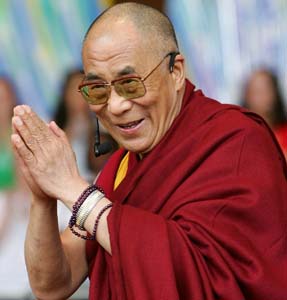Dalai Lama still a "wolf" to China, 50 years after flight
 Hongya, China - "Get out of here! They will arrest anyone who looks in there," cried a middle-aged woman standing near the closed red doors of a small temple in China's north-western province of Qinghai.
Hongya, China - "Get out of here! They will arrest anyone who looks in there," cried a middle-aged woman standing near the closed red doors of a small temple in China's north-western province of Qinghai.
The nervous taxi driver jumped into his car and started rolling downhill with the doors still open and his two passengers stranded.
The car had been parked in the mountain village of Hongya at the gate of what Chinese officials and tourists call the "Hongya Former Residence" with no sign to give the name of the illustrious former resident.
But thick sheaves of dozens of white silk scarves hung from the double brass door rings offered the biggest clue that this is a special place to some people.
The sensitivity of the walled compound stems from its attraction to Tibetan Buddhist pilgrims loyal to the 14th Dalai Lama, their exiled spiritual leader, who was born - or reincarnated, according to Tibetans - on this spot in 1935.
The Dalai Lama left his childhood home for education in Tibetan Buddhism two years after his birth, and 50 years ago, on March 17, 1959, he fled Tibet after a failed uprising against Chinese rule of the Himalayan region.
Police reportedly sealed off Hongya village, which is known as Taktser to Tibetans, for most of last year after violent protests against Chinese rule in many Tibetan areas from February to April.
"Last year, there were some police officers living in the Former Residence, but now, they're gone," said Su Rongke, a tour manager who regularly visits Hongya.
The Communist Party blames the "Dalai clique" for encouraging last year's violence, and many Chinese officials continue to vilify him as a "wolf in monk's robes."
"He has always done everything he could to promote 'Tibet independence' as well as incite ethnic conflicts," the official China Daily newspaper said in a commentary on the Dalai Lama after the rioting.
The 1989 Nobel Peace Prize laureate denied he was behind last year's violence, endorses non-violent protest and said he does not seek independence for Tibet but autonomy for it within China.
But China, anxious ahead of this month's 50 anniversaries, continues its closure of large Tibetan areas to foreigners, has deployed security forces to Tibetan communities and censors mentions of the Dalai Lama.
Su said most of the tourists who join his groups to Hongya are from overseas, especially areas such as Japan, Hong Kong and Taiwan.
Tibetans "rarely" join the tours while the Chinese web page for Su's company has to omit the name of the Dalai Lama from its titles to avoid blocking by state censors, he said.
According to the Dalai Lama's official biography, his parents were "small farmers who mostly grew barley, buckwheat and potatoes" in Hongya.
The Tibetan Buddhist leader had two sisters and four brothers who survived their infancy.
By the time Buddhist elders had used traditional divination and tests to find their highest tulku, or reincarnate lama, they had already recognized his oldest brother as the tulku Taktser Rinpoche.
"It was almost unthinkable that more than one tulku could be born into the same family, and certainly, my parents had no idea that I would be proclaimed Dalai Lama," he said on his official website, www. dalailama. com.
His youngest brother was identified later as the reincarnation of the spiritual leader Ngari Rinpoche.
The Dalai Lama, whose title is sometimes literally translated as "Ocean of Wisdom," was educated in Buddhism in Lhasa, the traditional capital of Tibet, at a time of great turbulence.
The Communist Party, led by Mao Zedong, proclaimed the People's Republic of China in October 1949, and People's Liberation Army troops took control of Tibet in 1951.
As a youth, the Dalai Lama travelled to Beijing to meet Mao in 1954, an event given great propaganda value by the Communist Party.
Five years later, after a failed uprising against Chinese rule, he received an "explicit instruction to leave the country" when he consulted the Nechung Oracle in Lhasa on March 17, 1959, according to his website.
"There was general fear that the Chinese were planning to abduct the Dalai Lama and take him away to Beijing," the Tibetan government-in-exile said in its account of his flight.
Aides disguised the Dalai Lama as a soldier in case the group ran into Chinese forces near the border. He and his family reached India after a three-week horse-back trek across the Tibetan plateau and the Himalayas.
About 80,000 Tibetans joined him in exile over the next few months, and tens of thousands more have followed in the past 50 years, most of them hiking over high, snow-covered passes to evade Chinese troops.
Video footage taken in 2006 near the Mount Everest Base Camp gave a rare insight into the difficulties faced by Tibetans attempting illegal border crossings into Nepal and India.
The video by Romanian mountaineers showed a young Tibetan woman collapsing onto the snow after apparently being shot by a Chinese soldier as a group of Tibetans climbed a high pass on China's border with Nepal.
Since last year's protests, China has reportedly increased border patrols and tightened security along the border.
The United Nations High Commission for Refugees recorded 596 arrivals at the Tibetan Reception Centre in Nepal last year, down from 2,156 in 2007. (dpa)